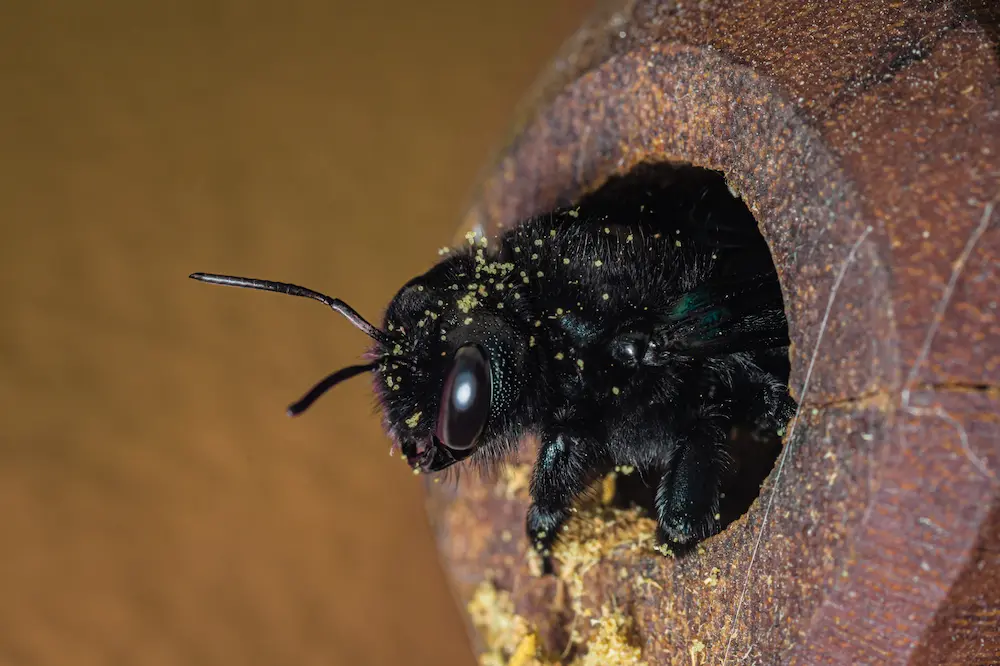
Stinging insects can ruin any beautiful, sunny day in Central Florida. When you hear a loud buzzing noise outdoors, it may be one of many of these pests, including the carpenter bee. The main difference between other stinging pests is carpenter bees will destroy your wood structures. These bees tend to be larger, have more black in their coloring, and have less hair compared to other bee species.
Carpenter bees get their name from digging and boring into wood structures. Their damage tends to look like small holes, along with a pile of sawdust near the openings.
At Sorko Services, we know how frustrating carpenter bees can be. That’s why we’ve put together this guide to help you confirm if you have carpenter bees on your property. And if you do, we offer expert pest control services, including expert carpenter bee removal and prevention.
How to Tell Carpenter Bees Apart from Other Bees
One thing to consider when telling these bees apart is that carpenter bees are solitary bees, meaning they don’t build hives. So if you spot a hive in or around your property, it’s not carpenter bees.
Carpenter bees are often confused with bumblebees since they look alike. But their abdomens are bare and shiny black, while bumblebees have yellow stripes and a hairy abdomen.
Here’s how to tell the difference between the two:
Carpenter Bee
- Size: ¼” to 1″ in length
- Color: A blue-black, green, or purple metallic sheen with a yellow midsection
- Nests: Nearly perfect holes approximately ½ inch in diameter. Usually located on the underside of any wood surface (including decks, siding, overhangs, fence posts, window frames, fascia boards, and soffits).
- Behavior: They do not swarm, live alone, and rarely sting. Although the female carpenter bee may sting if provoked.
Bumble Bee
- Size: ¾” to 1″ in length
- Color: Bands of contrasting black and yellow coloring.
- Nests: Usually burrowed in the ground, using abandoned rodent burrows and cavities beneath patio stones, piles of compost, landscape timbers, and bird nests (above ground). They do not typically nest in structures like carpenter bees do.
- Behavior: Live in hives and make honey and wax in their hives. They will sting if the hive is in danger, but most often ignore people.
If you’re not sure if you have carpenter bees, give a professional exterminator (like Sorko Services) a call. We can come out and take a look for you.
Ready for pest, lawn, or sprinkler service?
Ready for qualified professionals to help keep your home, business, or lawn in pristine condition?
Schedule Your FREE Estimate!
Get your home, lawn, and lake in pristine condition. Leave your information and we'll be in touch.
*During normal business hours. After hours calls will be returned the next business day.
What Does Carpenter Bee Damage Look Like?
Carpenter bees can cause a lot of damage to your home. They drill holes in wood to make their nests, which can weaken the structure of your deck, porch, or roof. Here are some signs of carpenter bee damage to watch for:
- Round holes about ½ inch wide in your wood
- Sawdust piles near the holes
- Stains on your wood from bee waste
- Bees flying in and out of the holes
Carpenter bees also leave brownish or yellowish excrement stains below their bored entrance holes.
If you see any of these signs, it’s time to call in the pros. The longer you wait, the worse the damage can get!
Stinging Insect Exterminators: The Best Way to Get Rid of Carpenter Bees
We’ve seen a lot of folks trying to get rid of carpenter bees on their own, using sprays or traps from the store. But these aren’t always effective, and they can be dangerous if you don’t know what you’re doing.
At Sorko Services, our experts know how to handle carpenter bees safely. We use safe, eco-friendly methods to control carpenter bee infestations. Our technicians are trained to find and remove their nests, so they don’t come back.
So let us handle the hard work, so you can relax and have fun outside again. If you’re ready to enjoy your yard without the buzz, reach out to us today to get started with a free quote.
Back to Bee and Wasp Control